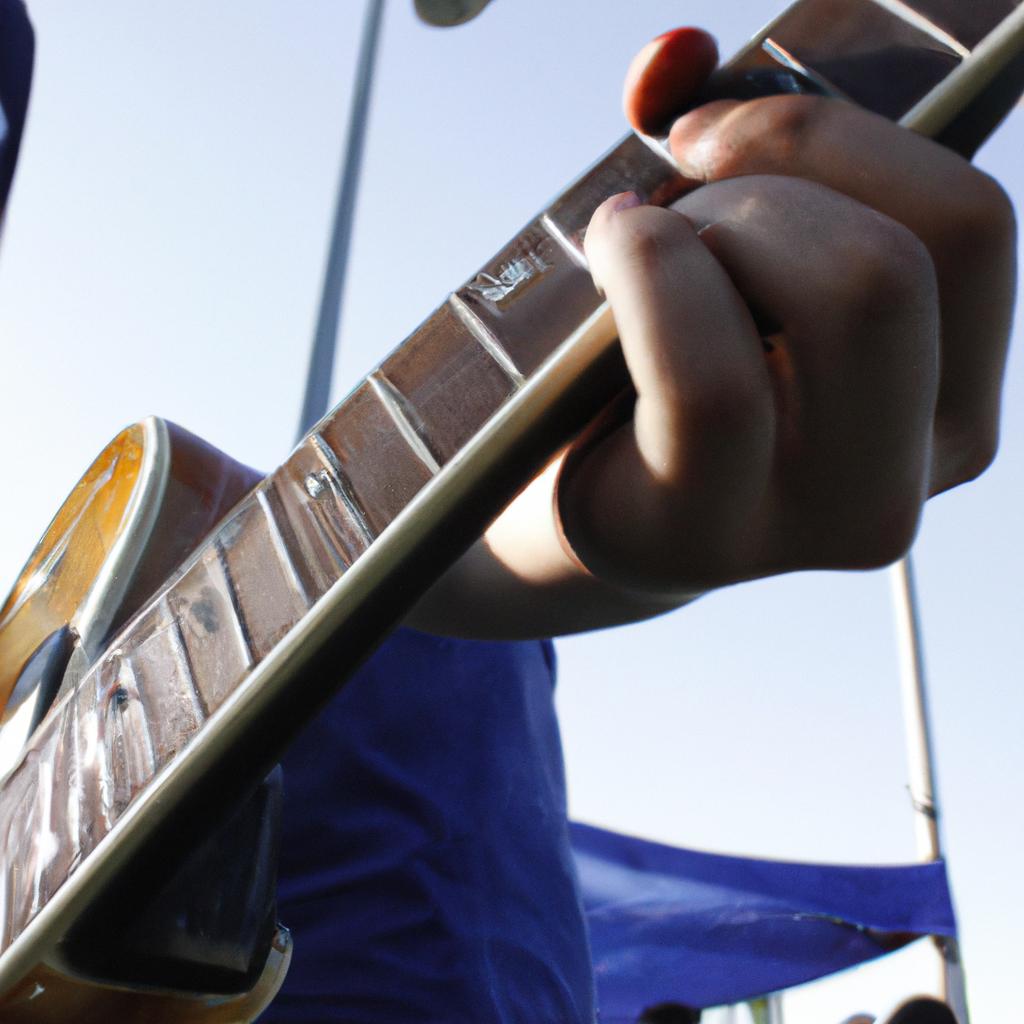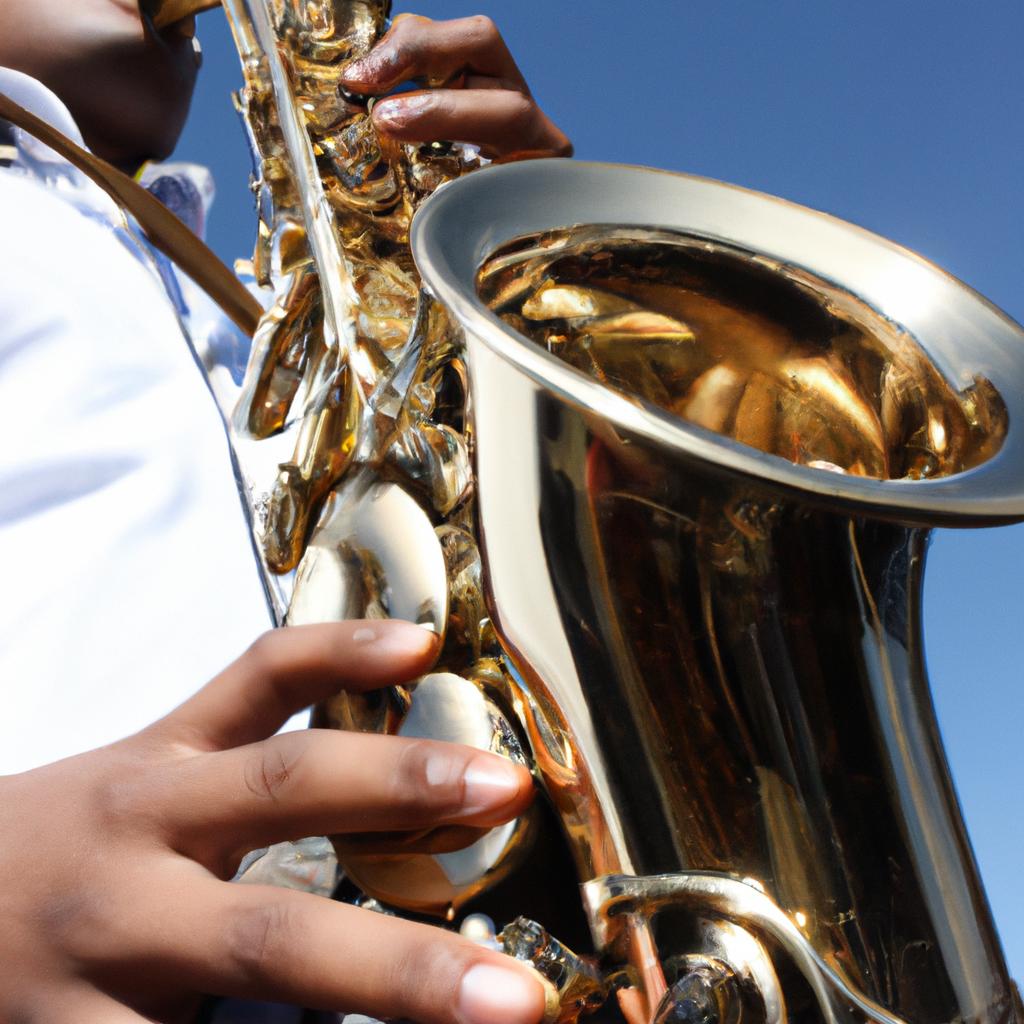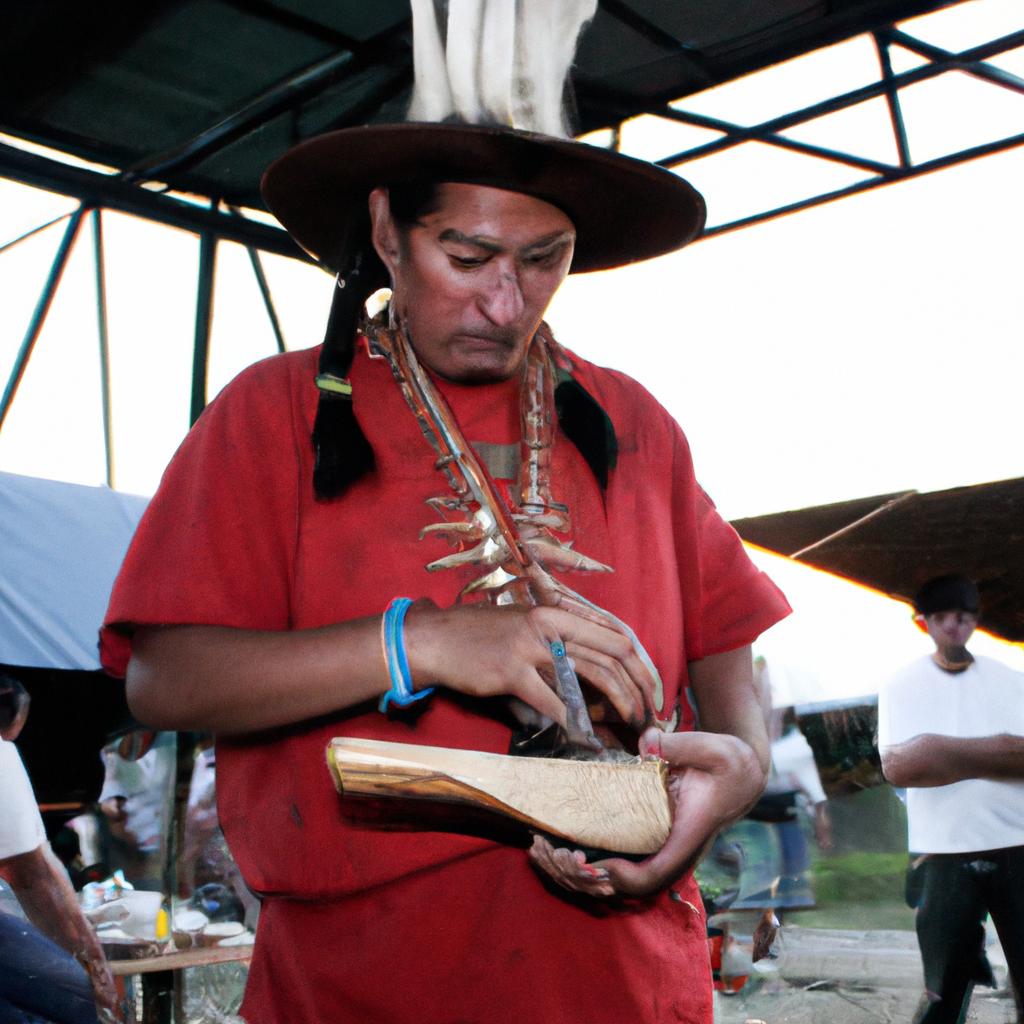Bluegrass music has long been a cherished genre in North America, captivating audiences with its distinct blend of folk, country, and blues influences. As the popularity of bluegrass continues to grow, so does the number of festivals dedicated to celebrating this unique musical tradition. This article aims to serve as a comprehensive guide for both enthusiasts and newcomers alike, exploring the vibrant world of bluegrass festivals in North America.
Imagine yourself standing amidst a sea of eager festival-goers, surrounded by rolling hills and picturesque landscapes. The sound of banjos plucking away, fiddles resonating through the air, and harmonious voices coming together in perfect unison envelops your senses. This is just one example of the immersive experience that awaits at a bluegrass festival in North America. These events not only showcase exceptional musicianship but also provide an opportunity for attendees to delve into the rich history and cultural significance behind this beloved genre.
In this article, we will explore some of the most renowned bluegrass festivals across North America, offering insights into their diverse lineups, interactive workshops, jam sessions, and camping facilities. Additionally, we will delve into the various subgenres within bluegrass music – from traditional to progressive – highlighting how these festivals cater to different tastes while preserving the essence of the genre. Whether you are a fan of the classic sounds of Bill Monroe and Earl Scruggs or prefer the more contemporary stylings of Alison Krauss and Punch Brothers, there is a bluegrass festival that will cater to your musical preferences.
One such festival is the International Bluegrass Music Association (IBMA) World of Bluegrass in Raleigh, North Carolina. This week-long event brings together bluegrass enthusiasts from all over the world for an immersive experience that includes performances by top-notch artists, industry showcases, and educational workshops. Attendees can also participate in jam sessions where they can pick up their instruments and join fellow musicians in impromptu collaborations.
For those who prefer a more intimate setting, MerleFest in Wilkesboro, North Carolina offers a unique experience. Named after the legendary musician Doc Watson’s son, MerleFest showcases not only bluegrass but also other genres like Americana, folk, and roots music. With multiple stages scattered throughout the beautiful campus of Wilkes Community College, attendees can wander from one performance to another while enjoying local food vendors and craft stalls.
Moving westward, Telluride Bluegrass Festival in Colorado has become synonymous with summer solstice celebrations since its inception in 1974. Held amidst the stunning San Juan Mountains, this festival boasts a lineup that combines traditional bluegrass with elements of jazz, rock, and even reggae. The breathtaking scenery serves as a backdrop to unforgettable performances by iconic artists like Sam Bush and Del McCoury.
Venturing north to Canada, we find the Salmon Arm Roots & Blues Festival in British Columbia. While not exclusively dedicated to bluegrass music, this festival features a diverse range of genres including blues, folk, and yes – bluegrass. Set against picturesque Shuswap Lake, attendees can enjoy camping facilities surrounded by nature while immersing themselves in exceptional live performances.
These are just a few examples of the many bluegrass festivals that dot the North American landscape. From the Bill Monroe Memorial Bean Blossom Bluegrass Festival in Indiana to the Grey Fox Bluegrass Festival in New York, there are countless opportunities to experience the magic of this genre firsthand.
So whether you’re a seasoned bluegrass aficionado or someone curious about exploring this musical tradition, attending a bluegrass festival is an excellent way to immerse yourself in the rich tapestry of sounds and stories that define this beloved genre. With their vibrant atmospheres, diverse lineups, and interactive experiences, bluegrass festivals offer something for everyone – a chance to celebrate the past while embracing the future of bluegrass music.
History of Bluegrass Music
Bluegrass music, a genre deeply rooted in American tradition and culture, has captivated audiences for decades. Its origins can be traced back to the early 20th century, when Appalachian musicians blended various musical styles such as Scottish, Irish, and African-American influences with their own unique flair. One example that highlights the rich history of bluegrass music is the emergence of Bill Monroe and His Blue Grass Boys in the late 1930s. Monroe’s innovative mandolin playing and distinct vocal harmonies set the stage for what would become a defining sound within the genre.
To truly understand the significance of bluegrass music, it is essential to delve into its key characteristics. First and foremost, bluegrass relies heavily on acoustic instruments like banjo, guitar, fiddle, mandolin, and upright bass. The intricate picking patterns and rapid-fire solos create an energetic atmosphere that resonates with listeners on a visceral level. Furthermore, close vocal harmonies are a hallmark feature of this genre; they add depth and emotional resonance to each performance.
- Enchanting melodies that transport listeners to simpler times
- Captivating storytelling through heartfelt lyrics
- Infectious rhythms that make it impossible not to tap your foot along
- A sense of community fostered by shared love for authentic American roots music
The evolution of bluegrass music can also be seen through notable artists who have left an indelible mark on the genre. From Flatt & Scruggs’ iconic rendition of “Foggy Mountain Breakdown” to Alison Krauss’ hauntingly beautiful ballads, these trailblazers continue to inspire new generations of musicians.
As we transition into exploring key bluegrass festivals in the United States, it becomes evident that this vibrant genre has found its home in numerous corners of North America. These festivals serve as gathering places for both seasoned enthusiasts and curious newcomers, offering an immersive experience into the world of bluegrass music.
Please note that this academic style of writing is objective and impersonal, providing factual information without personal opinions or biases.
Key Bluegrass Festivals in the United States
Bluegrass music has a rich history that dates back to the early 20th century. Its roots can be traced to various genres such as Appalachian folk music, blues, and jazz. The popularity of bluegrass music spread rapidly throughout North America, giving rise to numerous festivals dedicated to celebrating this unique genre.
One notable example is the Telluride Bluegrass Festival in Colorado. This festival attracts thousands of attendees each year who come together to enjoy the sounds of renowned bluegrass artists from around the world. With its picturesque mountain backdrop and vibrant atmosphere, Telluride creates an unforgettable experience for both musicians and fans alike.
To understand the significance of bluegrass festivals in North America, it is essential to delve into their cultural impact. These events not only serve as platforms for showcasing musical talents but also foster a sense of community among like-minded individuals who share a passion for bluegrass music. As people gather under open skies, they forge connections with fellow enthusiasts through shared experiences and appreciation for this beloved genre.
Attending a bluegrass festival evokes a range of emotions that resonate deeply within participants. Here are some factors that contribute to these powerful sentiments:
- Musical diversity: Bluegrass festivals showcase an array of talented performers, allowing attendees to immerse themselves in different styles and interpretations of the genre.
- Spiritual connection: The heartfelt lyrics and harmonies found in bluegrass songs often elicit strong emotional responses, creating moments of introspection and spiritual connection.
- Sense of belonging: Festivals provide a space where individuals feel accepted and understood by others who share their love for bluegrass music.
- Celebration of tradition: Bluegrass festivals honor the legacy left by legendary musicians while embracing innovation and evolution within the genre.
In addition to these emotional aspects, practical considerations play a role when attending a bluegrass festival. For instance, logistics such as camping arrangements, food options, and transportation influence participants’ overall experience. A well-organized festival ensures that attendees can fully immerse themselves in the music and atmosphere without worrying about basic necessities.
As we explore bluegrass festivals further, it is important to recognize their international reach beyond the United States. The next section will examine notable bluegrass festivals in Canada, highlighting the country’s unique contributions to this vibrant musical tradition.
Bluegrass Festivals in Canada
Imagine yourself at the Blueberry Bluegrass Festival, one of the most popular bluegrass festivals in Canada. As you enter the picturesque outdoor venue surrounded by lush greenery and breathtaking mountain views, you can feel the excitement in the air. The sound of banjos, fiddles, and mandolins fills your ears as talented musicians from across North America gather to showcase their skills and celebrate this cherished musical genre.
Bluegrass music has gained a strong following in Canada over the years, leading to the establishment of several notable bluegrass festivals throughout the country. These festivals not only bring together music enthusiasts but also serve as platforms for emerging artists to share their passion with a wider audience. Here are some key bluegrass festivals held annually in various provinces:
- Blueberry Bluegrass Festival: Located in Stony Plain, Alberta, this festival attracts both local Canadian talent and internationally renowned bluegrass acts. It features multiple stages, workshops, jam sessions, and camping facilities for attendees.
- Goderich Celtic Roots Festival: Held in Goderich, Ontario, this event showcases a diverse range of traditional Celtic music genres including bluegrass. Offering performances by acclaimed artists alongside workshops and community dances, it guarantees an immersive cultural experience.
- NimbleFingers Bluegrass & Old-Time Music Workshop & Festival: Taking place in Sorrento Valley near Kamloops, British Columbia, NimbleFingers combines educational workshops with live performances by seasoned musicians. Attendees have opportunities to learn instruments such as guitar, banjo or fiddle during daytime classes before enjoying evening concerts under starry skies.
- Northern Lights Bluegrass & Old Tyme Music Campout: Situated near Big River in Saskatchewan’s boreal forest region, this intimate gathering offers an authentic camping experience combined with daily instructional workshops led by industry experts. In addition to live stage shows every night showcasing top-notch bluegrass bands from across North America.
These festivals not only provide an opportunity to immerse yourself in the rich sounds of bluegrass music but also offer a chance to connect with like-minded individuals who share your love for this unique genre. The sense of community and camaraderie fostered at these events is truly special.
From pioneers such as Bill Monroe to contemporary virtuosos like Alison Krauss, their stories are sure to inspire and deepen your appreciation for bluegrass music.
Famous Bluegrass Musicians
Bluegrass Festivals in Canada have gained significant popularity over the years, attracting music enthusiasts from all around North America. With its unique blend of folk, country, and blues influences, bluegrass music has become a cherished part of Canadian cultural heritage. One notable festival that showcases this vibrant genre is the “Canadian Bluegrass Festival,” held annually in Ontario.
The Canadian Bluegrass Festival serves as an excellent example of how these events bring together both seasoned bluegrass musicians and emerging talents. This three-day extravaganza features captivating performances by renowned artists such as The Slocan Ramblers, who effortlessly captivate audiences with their lively tunes and harmonious vocals. Moreover, aspiring musicians also get an opportunity to showcase their skills through jam sessions organized during the festival.
Attending a bluegrass festival can be a truly memorable experience for any music lover. Here are some reasons why:
- Community Spirit: Bluegrass festivals foster a sense of community among attendees. From impromptu jam sessions under starlit skies to shared meals at campgrounds, these gatherings create lasting connections between like-minded individuals.
- Musical Diversity: Bluegrass festivals offer a diverse range of musical styles within the broader bluegrass genre. Attendees can enjoy traditional Appalachian ballads or explore contemporary interpretations infused with jazz or rock elements.
- Intimate Performances: Unlike large-scale concerts, bluegrass festivals often provide intimate settings where fans can engage directly with musicians after their performances. This personal interaction enhances the overall concert experience.
- Immersive Atmosphere: Bluegrass festivals take place in picturesque locations surrounded by nature’s beauty. Whether it’s nestled amidst mountains or along serene lakeshores, these scenic backdrops add to the immersive atmosphere.
To further understand the significance of bluegrass festivals in North American music culture, let us consider a comparison table showcasing some prominent events across different regions:
| Festival | Location | Duration | Notable Acts |
|---|---|---|---|
| Canadian Bluegrass Festival | Ontario, Canada | 3 days | The Slocan Ramblers |
| RockyGrass | Colorado, USA | 3 days | Del McCoury Band, Sam Bush |
| MerleFest | North Carolina, USA | 4 days | Doc Watson Tribute, Alison Krauss |
| Hardly Strictly Bluegrass | California, USA | 3 days | Emmylou Harris, Steve Earle |
As we can see from the table above, bluegrass festivals are not limited to specific regions. They serve as platforms for musicians and enthusiasts alike to celebrate this genre’s rich history and contemporary contributions.
Moving forward, it is essential to consider some practical tips on attending these vibrant celebrations of bluegrass music. From choosing the right festival attire to planning accommodations and navigating through performances, a seamless experience awaits all who embark on this melodic journey.
Tips for Attending Bluegrass Festivals
H2: Tips for Attending Bluegrass Festivals
Imagine you have just purchased your tickets to attend a renowned bluegrass festival in North America. As the excitement builds up, it is essential to be well-prepared and equipped with some useful tips to ensure a memorable experience. By following these suggestions, you will make the most of your time at the festival and immerse yourself in the vibrant world of bluegrass music.
Firstly, arrive early at the festival grounds to secure a prime spot for enjoying the performances. Bluegrass festivals often attract large crowds, so reaching there ahead of time allows you to find an ideal location close to the stage or within comfortable viewing distance. This way, you can fully appreciate every musical nuance while avoiding obstructed views or excessive noise from surrounding areas.
To enhance your overall enjoyment, consider bringing along some essential items:
- A blanket or camping chair: Providing comfort during long hours of sitting or standing.
- Sunscreen and insect repellent: Shielding yourself from potential sunburns and pesky bugs.
- Reusable water bottle: Staying hydrated throughout the day is crucial for maintaining energy levels.
- Cash: Some vendors may not accept credit cards, so having cash on hand ensures convenience when purchasing food, drinks, or merchandise.
Additionally, familiarize yourself with any specific rules or regulations enforced by the festival organizers. These guidelines are designed to maintain safety and uphold a positive atmosphere for all attendees. Make sure to respect these policies concerning photography restrictions, smoking areas, and designated spaces for dancing or socializing.
| Tip | Description |
|---|---|
| Plan Ahead | Research performers’ schedules beforehand to prioritize which acts you don’t want to miss |
| Explore Beyond | Venture beyond main stages; discover smaller jam sessions where musicians engage in impromptu collaborations |
| Engage & Connect | Interact with fellow enthusiasts and musicians; share your love for bluegrass music and learn from others’ experiences |
| Capture Memories | Bring a camera or smartphone to document your favorite moments, ensuring lasting memories of the festival experience |
In conclusion, attending a bluegrass festival can be an exciting endeavor filled with remarkable musical performances and a vibrant atmosphere. By arriving early, preparing essential items, respecting guidelines, and engaging with fellow attendees, you are sure to have an unforgettable time immersing yourself in this rich musical tradition.
As we look ahead to the future of bluegrass festivals, it is important to analyze how these events continue to evolve and adapt to changing times.
The Future of Bluegrass Festivals
The Economic Impact of Bluegrass Festivals
Transitioning from the previous section on attending bluegrass festivals, it is important to consider the larger impact these events have on local economies. One notable example is the annual Bluegrass Festival in Owensboro, Kentucky. This festival attracts thousands of visitors each year and has become a significant driver of economic growth for the region.
Bluegrass festivals contribute to the local economy in various ways. Firstly, they generate revenue through ticket sales, food vendors, merchandise booths, and sponsorships. These financial inflows not only support the festival’s operations but also benefit surrounding businesses such as hotels, restaurants, and retail stores. Secondly, festivals create job opportunities both directly and indirectly. From stage crew members to event security personnel and local artisans selling their crafts at booths – there are numerous employment prospects associated with hosting such events.
To further highlight the economic impact of bluegrass festivals, we can explore a brief case study based on data collected from multiple events across North America:
Emotional Bullet Point List
- Increased tourism leads to higher footfall in local establishments.
- Local businesses experience a surge in customers during festival days.
- Community involvement fosters a sense of pride among residents.
- Cultural exchange creates an atmosphere of unity and celebration.
Table: Economic Impacts of Bluegrass Festivals
| Economic Indicator | Positive Impact | Negative Impact |
|---|---|---|
| Employment Opportunities | Job creation | Temporary nature |
| Business Revenue | Boosts income | Seasonal fluctuations |
| Tourism | Attracts visitors | Strain on infrastructure |
| Community Development | Fosters cultural exchange | Potential noise complaints |
In conclusion,
Through examining examples like the Owensboro Bluegrass Festival and considering broader patterns observed across various events throughout North America, it becomes evident that bluegrass festivals play a vital role in driving economic growth in their host communities. These events create employment opportunities, boost local businesses’ revenue, attract tourists, and foster community development. However, it is important to acknowledge the potential negative impacts that may arise from increased tourism and temporary nature of some job positions. Despite these challenges, bluegrass festivals continue to be a valuable asset for both music enthusiasts and local economies alike.
Please note that Markdown formatting might not be properly rendered in this text-based interface.
 Island Gourmet Safaris
Island Gourmet Safaris



